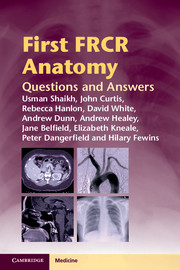Examination 7
Published online by Cambridge University Press: 05 March 2012
Summary
Axial CT pelvis (bone windows)
Posterior column of the left acetabulum. The posterior and anterior columns of acetabulum provide the dominant load-bearing support of the hip joint. It is important to evaluate the integrity of the acetabular columns in the setting of pelvic trauma as fracture involvement of these structures is integral to all classification systems of acetabular fractures.
Left rectus abdominis muscle. This is a strap-like muscle encased in a fascial sheath. It inserts onto the anterior surface of the pubic symphysis and has an aponeurosis which is continuous with that of the gracilis and adductor longus muscles.
Right obturator internus. This arises from the internal surface of the medial acetabulum and inserts on the greater trochanter of the femur. Its action is to produce external rotation of the hip.
Right sartorius muscle. This arises from the anterior superior iliac spine. It has a long muscle belly directed distally and medially spanning the hip and knee joints with an insertion on the antero-medial aspect of the tibia as one of the pes anseurinus tendon group.
Greater trochanter of the left femur.
Lateral radiograph thoracolumbar spine
T11/T12 disc space.
T12 vertebral body.
Twelfth rib.
L1 pedicle.
L1/L2 facet joint.
- Type
- Chapter
- Information
- First FRCR AnatomyQuestions and Answers, pp. 187 - 192Publisher: Cambridge University PressPrint publication year: 2012



